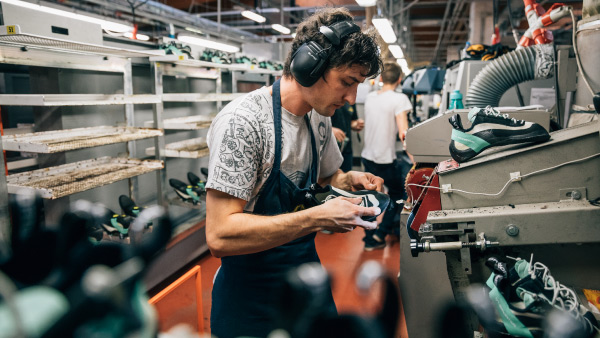
5 Things You Need to Know Before Buying Your Next Pair of Climbing Shoes
Are you ready to take your climbing game to the next level? The right pair of shoes can make a huge difference in your performance and comfort, whether you're climbing outdoors or on the wall. If you're getting into climbing or finally investing in your own gear, we know you're probably wondering, "how do I go about finding the perfect shoes?". Don't worry; we've got you covered.
We've put together this helpful guide with five things you need to know before buying your next pair of climbing shoes. Keep reading to learn more about how to choose the right climbing shoe for you, including how they should fit and what to consider when making your decision. With this guide as your trusty companion, you're sure to find a climbing shoe that will elevate your experience on the wall; let's get started!
1. Indoor vs Outdoor Climbing Shoes: Choose the Right Shoe for the Job
The first factor you should consider when considering how to choose climbing shoes is where you'll be climbing most of the time.
Indoor climbing shoes are designed for climbing on plastic holds. For beginners, a neutral climbing shoe will work best. This type of shoe features a flat profile for better traction on smooth indoor walls that you typically find in most bouldering and gym climbing centres. Alternatively, a moderate to aggressive style with downturned shoes and pointed toes will work for intermediate to advanced climbers with more technical expertise.
Sport climbing is another setting where the right climbing shoes are super important. Crack climbers are looking for comfortable flat shoes that can fit into cracks whilst maintaining high performance. Choosing the right shoes will also depend on the type of terrain you climb the most (vertical or overhanging). When climbing vertically, a neutral and stiff shoe will give you the most support on those small edges. In contrast, a downturned soft shoe will allow you to dig deeper on overhanging terrain.
On the other hand, outdoor climbing shoes should have thicker rubber soles that provide more grip when climbing on natural rock. This thicker rubber outsole also offers added comfort and durability to withstand longer outdoor climbs.
If you plan to mix indoor and outdoor climbing, look for a shoe with an all-around design that can handle both surfaces. A moderate climbing shoe would work best here, most applicable to the widest range of climbing styles and types.
Shoe Types by Wall Characteristics
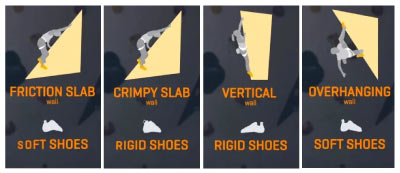
Indoor Climbing
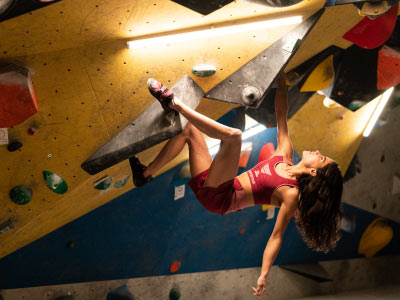
Outdoor Climbing

2. Understand Rock Climbing Shoe Types: Neutral, Moderate & Aggressive Shoes
It's important to be aware of the three main types of climbing shoes: neutral, moderate and aggressive shoes.
Neutral shoes are designed for versatility and can be used in a variety of rock climbing scenarios. They're great for beginner climbers who want a shoe with a stiff sole that will perform in multiple situations and enable them to develop precise footwork techniques without sacrificing comfort or flexibility.
Moderate shoes are an intermediate-level climbing shoe offering a thinner rubber outsole and soft shoe to enable more control and sensitivity while on the wall. This is a great option for an indoor climbing gym, as this shoe type should be removed after completing a route to allow your feet to breathe.
Alternatively, an aggressive shoe is made with a more pointed and downturned toe, which makes them perfect for technical climbs and overhanging routes since they help you grip the rock better. However, they can be uncomfortable if worn for extended periods of time.
3. A Comfortable Snug Fit: Know Your Shoe Size and How Climbing Shoes Should Fit
Now that you know the different types of climbing shoes, it's important to understand how they should fit. Climbing shoes should be tight and snug but not too tight. Your toes should feature a slight and comfortable curve in more aggressive shoes for a powerful position while climbing. However, they should not be uncomfortably scrunched or pressed up against the shoe.
On the other hand, if there's any dead space or gaps around your big toe or wiggle room in the toebox in general that might be causing your foot to move around in the climbing shoe, it's too big. Your heel should fit comfortably inside the heel cup and not slip out when you walk or climb.
A loose shoe with dead space can interfere with your climbing performance and cause the foot to shift from the heel cup. From heel hooking to toe hooking, the right fit is essential.
The most crucial part of getting the right fit is trying multiple pairs before buying. At our Brisbane K2 Base Camp store in Fortitude Valley, we have a climbing wall in-store, so you can try and test out a range of brands and climbing shoe styles to find one that suits you.
4. Choose the Right Closure System: Lace Ups or Velcro?
A climbing shoe's closure system is important for comfort and performance. Lace up shoes provide the most adjustable fit and can be customised and tightened for more support on steep routes. Velcro shoes are the most common and are great for novice climbers because they're easy to put on and take off.
Both types of shoe closures are light wear and can be slipped on while still providing a snug fit that keeps your foot in place when climbing. However, lace-ups may be more challenging to get on and off due to their firm, tight, non-slip design.
Slip-on climbing shoes are great for training or speed climbing as they don't require a super technical fit but are easiest to get on and off.
Lace Up
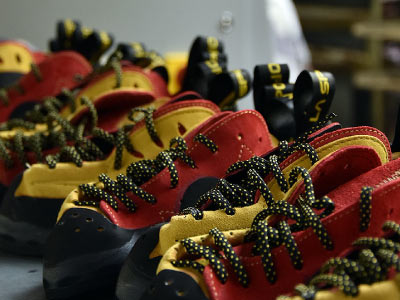
Velcro
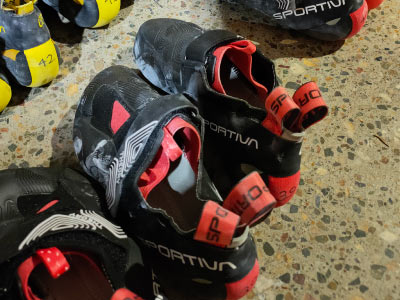
Slip-on
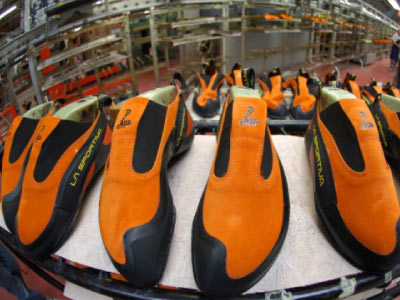
5. Consider Quality, Durability, and Price: Look for Long Lasting Shoes
When it comes to climbing shoes, quality should be your top priority. A pair of rock climbing shoes can be subject to a lot of wear and tear, so look for ones that are made with durable materials that can withstand the elements; here's a short list of materials to think about when deciding between different makes of shoes:
Leather vs Synthetic Shoes
Most modern climbing shoes are no longer wholly made of a leather canvas and body, but It is possible to find a leather shoe with full leather or lined leather upper. At K2, our most popular climbing shoes in this category have lined leather uppers, with the climbing shoes' stretch factor being slightly greater than older styles.
When choosing climbing shoes, we recommend that leather shoes be sized quite tightly since they can often stretch up to a full size. You can expect your shoes to become fully stretched and moulded to your foot shape and use after about a month of regular use, several times per week.
When fitting a new pair of synthetic shoes, keep in mind that they don't stretch nearly as much as leather shoes. It will still be possible to break them in a bit so that they mould to the shape of your foot, but they stay considerably tighter compared to leather or suede climbing shoes. If you're looking for something in between, shoes like the La Sportiva Katana Lace Climbing Shoe are comprised of both a leather and synthetic upper.
Rubber Outsoles
A harder rubber outsole will be more durable, giving the climber more support (good on long routes) on steep vertical climbing. Softer rubber will be more sticky, giving the climber more sensitivity; however, the trade-off is that this sort of rubber will wear faster.
Also, consider how often you will use your shoes and what terrain you plan to climb. This will help you decide if it's worth investing in a more premium pair designed for extreme conditions or if a cheaper, all-rounder shoe will suffice.
Generic Rubber Comparison
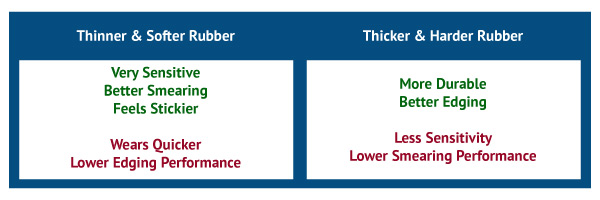
La Sportiva Climbing Shoe Rubber Technology

Following these five simple steps, you should be well-equipped to select the best pair of shoes for your needs. Whether it's lead climbing, outdoor climbing, or bouldering at your local climbing gym - you should be ready to smash out some sets in your new shoes! Don't hesitate to come on down to the K2 Store in Fortitude Valley, Brisbane or contact us for some one-on-one assistance and answers to all the questions you can think of -- we're here to help.
Now that you know how to choose climbing shoes that are the perfect fit, start exploring the world of rock climbing, and remember that anything is possible with the right shoes and attitude. So don't be afraid to take risks and challenge yourself. Get out there and enjoy the experience!




